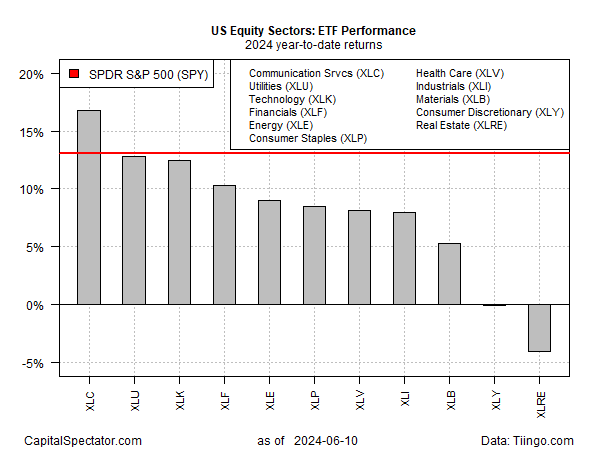
Most US Equity Sectors Are Up This Year—With Two Exceptions

Add in the potential for capital appreciation in REITs (if you’re so inclined), after a bruising couple of years, and the outlook looks relatively attractive, some analysts argue…The US stock market’s strong year-to-date gain so far in 2024 has enjoyed wide support among equity sectors…On…
The US stock market’s strong year-to-date gain so far in 2024 has enjoyed wide support among equity sectors. The two glaring downside exceptions: consumer discretionary and real estate shares, based on a set of ETFs through Monday’s close (June 10).
On the upside, the communications services sector (XLC) is the clear leader. Indeed, this fund, which holds the likes of Meta, Alphabet and Netflix, has soared 16.8% so far this year. Not only is that a strong performance in absolute terms, it’s also beating the broad market (SPY), which is up 13.1%. In fact, XLC is the only sector that’s ahead of stocks overall in 2024.
The loser’s circle this year is limited to consumer discretionary shares (XLY), which is posting a fractional loss, and real estate stocks (XLRE), which are in the red by 4.1%.
XLRE holds commercial real estate investment trusts (REITs), which have struggled since the Federal Reserve started raising interest rates in early 2022. REITs are prized for their relatively high dividend payouts, but competition from risk-free Treasuries has been a tough(er) act to beat lately.
Contrarians argue that REITs are an intriguing value play. XLRE’s 3.51% trailing 12-month yield, according to Morningstar.com, is a factor. That’s nearly 80% of the current 10-year Treasury yield. Add in the potential for capital appreciation in REITs (if you’re so inclined), after a bruising couple of years, and the outlook looks relatively attractive, some analysts argue.
Maybe, but the technical profile for XLRE still leaves room for doubt. The ETF has rallied off its late-2023 low, but the price trend still looks weak. The outlook, from a technical perspective, would look brighter if XLRE can move above its recent peak of ~40. That breakout may be brewing in the near term, but at the moment optimism is limited to expecting a trading range.
On the bright side, XLRE has tested its downside support of roughly 32 and, so far, it’s held. That’s a sign that the worst may have passed for REITs. A rate cut by the Fed would help, but that’s still not on the immediate horizon, according to Fed funds futures.
How is recession risk evolving? Monitor the outlook with a subscription to:
The US Business Cycle Risk Report
Author: James Picerno


